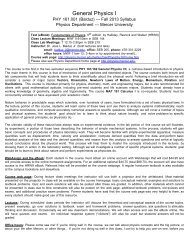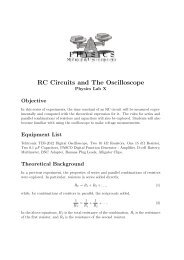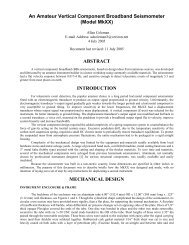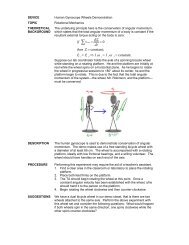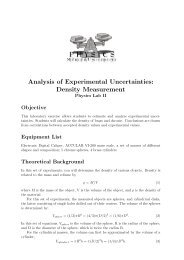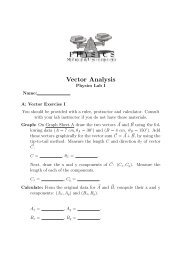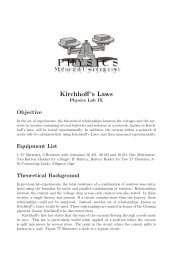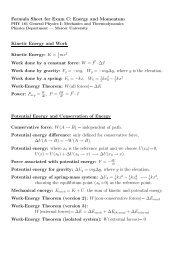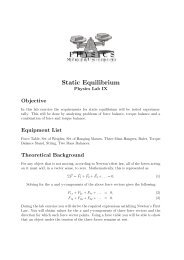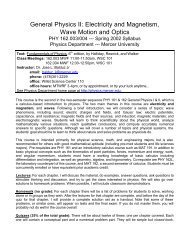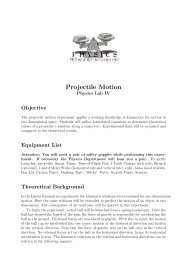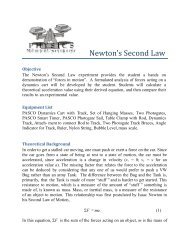Amateur Horizontal Component Seismometer, with Passive Leveling ...
Amateur Horizontal Component Seismometer, with Passive Leveling ...
Amateur Horizontal Component Seismometer, with Passive Leveling ...
Create successful ePaper yourself
Turn your PDF publications into a flip-book with our unique Google optimized e-Paper software.
S waves, placing markers at the proper locations on the seismograms. WinQuake also performed FFT analyses on a maximum<br />
of 1439 minutes of continuously sampled velocity data. The movable software cursor had a +/- 2 seconds visual positional<br />
accuracywhen “picking”discrete velocity wave peaks.<br />
VAULT LOCATION AND CONDITIONS<br />
<strong>Seismometer</strong> co-ordinates:<br />
Latitude: 47.849 N<br />
Longitude: 122.328 W<br />
Elevation: 110 meters<br />
Sensitive axis alignment: E-W<br />
The passive leveling feature was put to the ultimate test; for the entire duration of the experiment, the seismometer<br />
was installed on the basement floor of a house, approximately 10 meters from the data logger. Each of the seismometer’s<br />
leveling feet were supported by a piece of 4” square by ¼” thick plate glas, pressing on a plastic bag spread across carpeting<br />
12-15mm thick covering the concrete floor slab. According to a geologic map, over 200+ meters of unconsolidated glacial till<br />
separated bedrock from the floor slab. Ambient basement temperatures, at floor level, ranged 10 - 15º C. For the entire one<br />
month data was collected, very favorable weather conditions prevailed. Outside wind conditions were calm, their velocities<br />
scarcely exceeding a few kilometers per hour.<br />
RESULTS<br />
Short Period:<br />
Carpeting under the seismometer reduced its high frequency sensitivity, by at least 15dB, to the 20-30 freight trains<br />
passing by every day one kilometer away, but their passage was still very recognizable.<br />
Long Period:<br />
Tilt noise was evident in the broad band data, diminishing progressively towards the lower frequencies. Seismograms<br />
of teleseismic events (Figures 10 & 11) required narrow 0.03-0.08 Hz pass band filters to extract body and surface wave<br />
details. Individuals walking <strong>with</strong>in 5 meters of the seismometer produced long period disturbances, recognizable in the data as<br />
randomly placed spikes protruding out of the noise in the 1439 minute time series selected for later FFT analysis (Figures 12 &<br />
15).<br />
Very Long Period:<br />
Individual time sets containing 1439 minutes of continuous velocity data after fast Fourier transformation (Figures 13,<br />
18 & 20), produced spectrums down to 1 mHz, a minimum frequency set by WinQuake. After expanding the low end of the<br />
FFT spectrum (Figures 14, 19 & 21), spheroidal and toroidal modes were very carefully picked manually and identified using a<br />
published list [13] of frequencies centered on discrete acceleration peaks. Each expanded FFT spectrum uncovered both<br />
fundamental and overtone modes (singlet and multiplet) of free oscillations in the 1-2 mHz band as wel as the earth’s “hum”<br />
in the 2-7 mHz band. Velocity waves, 90º out of phase <strong>with</strong> acceleration, were compressed narrow enough in the spectrograms<br />
to make picking modes straight forward. Movement of people near the seismometer, seen in the raw signal as narrow spikes,<br />
formed peaks <strong>with</strong> 1.2-1.3 mHz center frequencies. One times series, 2 nd ordered low pass filtered to 0.001 Hz (Figure 16),<br />
contained waves having periods between 19-26 minutes, including a couple of suspect longer period waves. For one example,<br />
see Figure 17.<br />
An old panel mount analog galvanometer connected to pin 6 of op amp U15 (see Figure 9) continuously monitored the<br />
“mass position”of the pendulum. Meter’s needle did not move visually (



